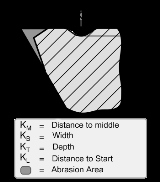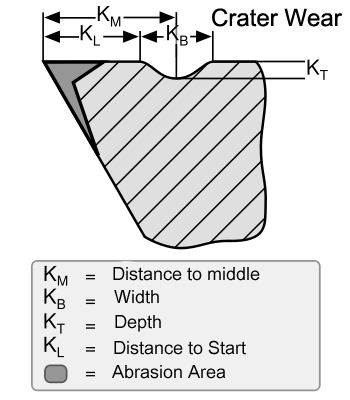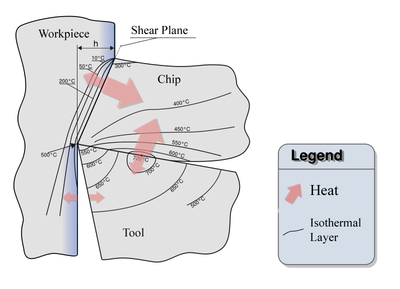
Tool wear
Encyclopedia
Tool wear describes the gradual failure of cutting tools due to regular operation. It is a term often associated with tipped tool
s, tool bit
s, or drill bit
s that are used with machine tool
s.
Types of wear include:
Can be caused by spindle speed that is too low or a feed rate that is too high. In orthogonal cutting this typically occurs where the tool temperature is highest. Crater wear occurs approximately at a height equaling the cutting depth of the material. Crater wear depth ~ t0
t0= cutting depth

Reduction in tool wear can be accomplished by using lubricants and coolant
s while machining. These reduce friction and temperature, thus reducing the tool wear.
A more general form of the equation is
where
 At high temperature zones crater wear occurs.
At high temperature zones crater wear occurs.
The highest temperature of the tool can exceed 700 °C and occurs at the rake face whereas the lowest temperature can be 500 °C or lower depending on the tool.
comes in the form of heat from tool friction
. It is a reasonable assumption that 80% of energy from cutting is carried away in the chip. If not for this the workpiece and the tool would be much hotter than what is experienced. The tool and the workpiece each carry approximately 10% of the energy. The percent of energy carried away in the chip increases as the speed of the cutting operation increases. This somewhat offsets the tool wear from increased cutting speeds. In fact, if not for the energy taken away in the chip increasing as cutting speed is increased; the tool would wear more quickly than is found.
Tipped tool
A tipped tool generally refers to any cutting tool where the cutting edge consists of a separate piece of material, either brazed, welded or clamped on to a separate body. Common materials for tips include tungsten carbide, polycrystalline diamond, and cubic boron nitride...
s, tool bit
Tool bit
The term tool bit generally refers to a non-rotary cutting tool used in metal lathes, shapers, and planers. Such cutters are also often referred to by the set-phrase name of single-point cutting tool. The cutting edge is ground to suit a particular machining operation and may be resharpened or...
s, or drill bit
Drill bit
Drill bits are cutting tools used to create cylindrical holes. Bits are held in a tool called a drill, which rotates them and provides torque and axial force to create the hole. Specialized bits are also available for non-cylindrical-shaped holes....
s that are used with machine tool
Machine tool
A machine tool is a machine, typically powered other than by human muscle , used to make manufactured parts in various ways that include cutting or certain other kinds of deformation...
s.
Types of wear include:
- flank wear in which the portion of the tool in contact with the finished part erodes. Can be described using the Tool Life Expectancy equation.
- crater wear in which contact with chips erodes the rake face. This is somewhat normal for tool wear, and does not seriously degrade the use of a tool until it becomes serious enough to cause a cutting edge failure.
Can be caused by spindle speed that is too low or a feed rate that is too high. In orthogonal cutting this typically occurs where the tool temperature is highest. Crater wear occurs approximately at a height equaling the cutting depth of the material. Crater wear depth ~ t0
t0= cutting depth
- built-up edge in which material being machined builds up on the cutting edge. Some materials (notably aluminum and copperCopperCopper is a chemical element with the symbol Cu and atomic number 29. It is a ductile metal with very high thermal and electrical conductivity. Pure copper is soft and malleable; an exposed surface has a reddish-orange tarnish...
) have a tendency to annealAnnealing (metallurgy)Annealing, in metallurgy and materials science, is a heat treatment wherein a material is altered, causing changes in its properties such as strength and hardness. It is a process that produces conditions by heating to above the recrystallization temperature, maintaining a suitable temperature, and...
themselves to the cutting edge of a tool. It occurs most frequently on softer metals, with a lower melting point. It can be prevented by increasing cutting speeds and using lubricant. When drilling it can be noticed as alternating dark and shiny rings. - glazing occurs on grinding wheelGrinding wheelA grinding wheel is an expendable wheel that is composed of an abrasive compound used for various grinding and abrasive machining operations...
s, and occurs when the exposed abrasiveAbrasiveAn abrasive is a material, often a mineral, that is used to shape or finish a workpiece through rubbing which leads to part of the workpiece being worn away...
becomes dulled. It is noticeable as a sheen while the wheel is in motion. - edge wear, in drills, refers to wear to the outer edge of a drill bitDrill bitDrill bits are cutting tools used to create cylindrical holes. Bits are held in a tool called a drill, which rotates them and provides torque and axial force to create the hole. Specialized bits are also available for non-cylindrical-shaped holes....
around the cutting face caused by excessive cutting speed. It extends down the drill flutes, and requires a large volume of material to be removed from the drill bit before it can be corrected.

Effects of Tool Wear
Some General effects of tool wear include:- increased cutting forces....
- increased cutting temperatures
- poor surface finish
- decreased accuracy of finished part
Reduction in tool wear can be accomplished by using lubricants and coolant
Coolant
A coolant is a fluid which flows through a device to prevent its overheating, transferring the heat produced by the device to other devices that use or dissipate it. An ideal coolant has high thermal capacity, low viscosity, is low-cost, non-toxic, and chemically inert, neither causing nor...
s while machining. These reduce friction and temperature, thus reducing the tool wear.
Tool Life Expectancy
The Taylor Equation for Tool Life Expectancy provides a good approximation.A more general form of the equation is
where
 =cutting speed
=cutting speed- T=tool life
- D=depth of cut
- S=feed rate
- x and y are determined experimentally
- n and C are constants found by experimentation or published data; they are properties of tool material, workpiece and feed rate.
Temperature Considerations

The highest temperature of the tool can exceed 700 °C and occurs at the rake face whereas the lowest temperature can be 500 °C or lower depending on the tool.
Energy Considerations
EnergyEnergy
In physics, energy is an indirectly observed quantity. It is often understood as the ability a physical system has to do work on other physical systems...
comes in the form of heat from tool friction
Friction
Friction is the force resisting the relative motion of solid surfaces, fluid layers, and/or material elements sliding against each other. There are several types of friction:...
. It is a reasonable assumption that 80% of energy from cutting is carried away in the chip. If not for this the workpiece and the tool would be much hotter than what is experienced. The tool and the workpiece each carry approximately 10% of the energy. The percent of energy carried away in the chip increases as the speed of the cutting operation increases. This somewhat offsets the tool wear from increased cutting speeds. In fact, if not for the energy taken away in the chip increasing as cutting speed is increased; the tool would wear more quickly than is found.
See also
- machine toolMachine toolA machine tool is a machine, typically powered other than by human muscle , used to make manufactured parts in various ways that include cutting or certain other kinds of deformation...
- tool bitTool bitThe term tool bit generally refers to a non-rotary cutting tool used in metal lathes, shapers, and planers. Such cutters are also often referred to by the set-phrase name of single-point cutting tool. The cutting edge is ground to suit a particular machining operation and may be resharpened or...
- tipped toolTipped toolA tipped tool generally refers to any cutting tool where the cutting edge consists of a separate piece of material, either brazed, welded or clamped on to a separate body. Common materials for tips include tungsten carbide, polycrystalline diamond, and cubic boron nitride...
- drill bitDrill bitDrill bits are cutting tools used to create cylindrical holes. Bits are held in a tool called a drill, which rotates them and provides torque and axial force to create the hole. Specialized bits are also available for non-cylindrical-shaped holes....
- drill press
- honingHoningHoning may refer to:* Honing , machining a surface by scrubbing an abrasive stone against it* Sharpening edged tools with a manual hone* Henkjan Honing , Dutch musician* Honing, Norfolk, English village* Playing Heroes of Newerth...
- cuttingCuttingCutting is the separation of a physical object, or a portion of a physical object, into two portions, through the application of an acutely directed force. An implement commonly used for cutting is the knife or in medical cases the scalpel...



